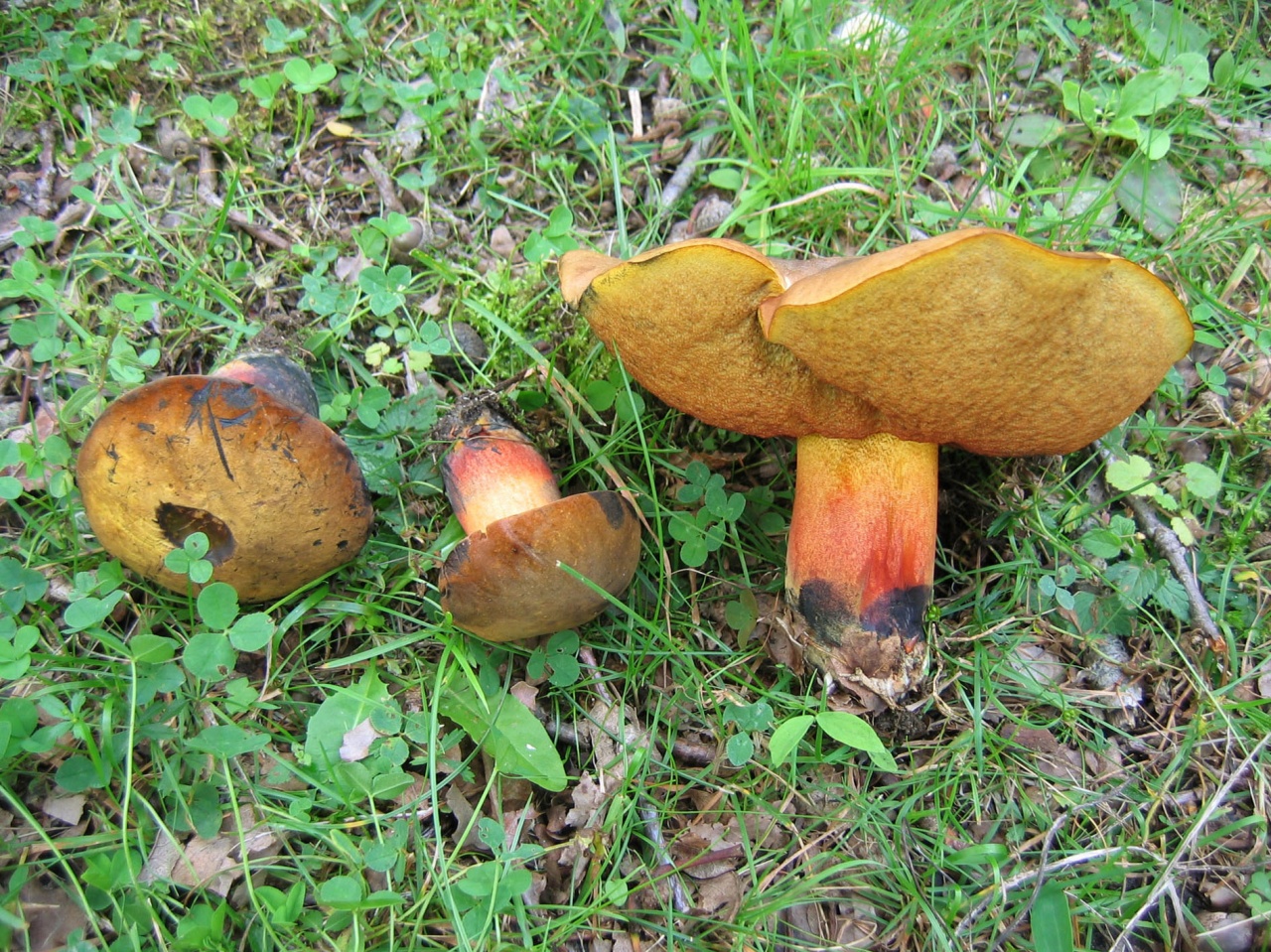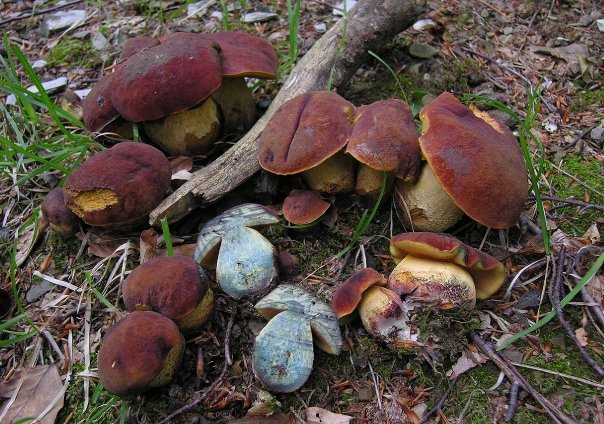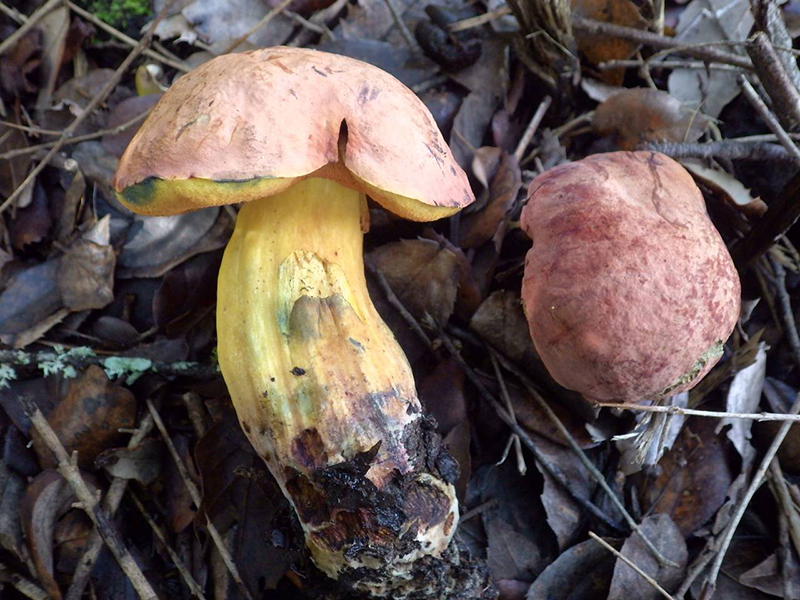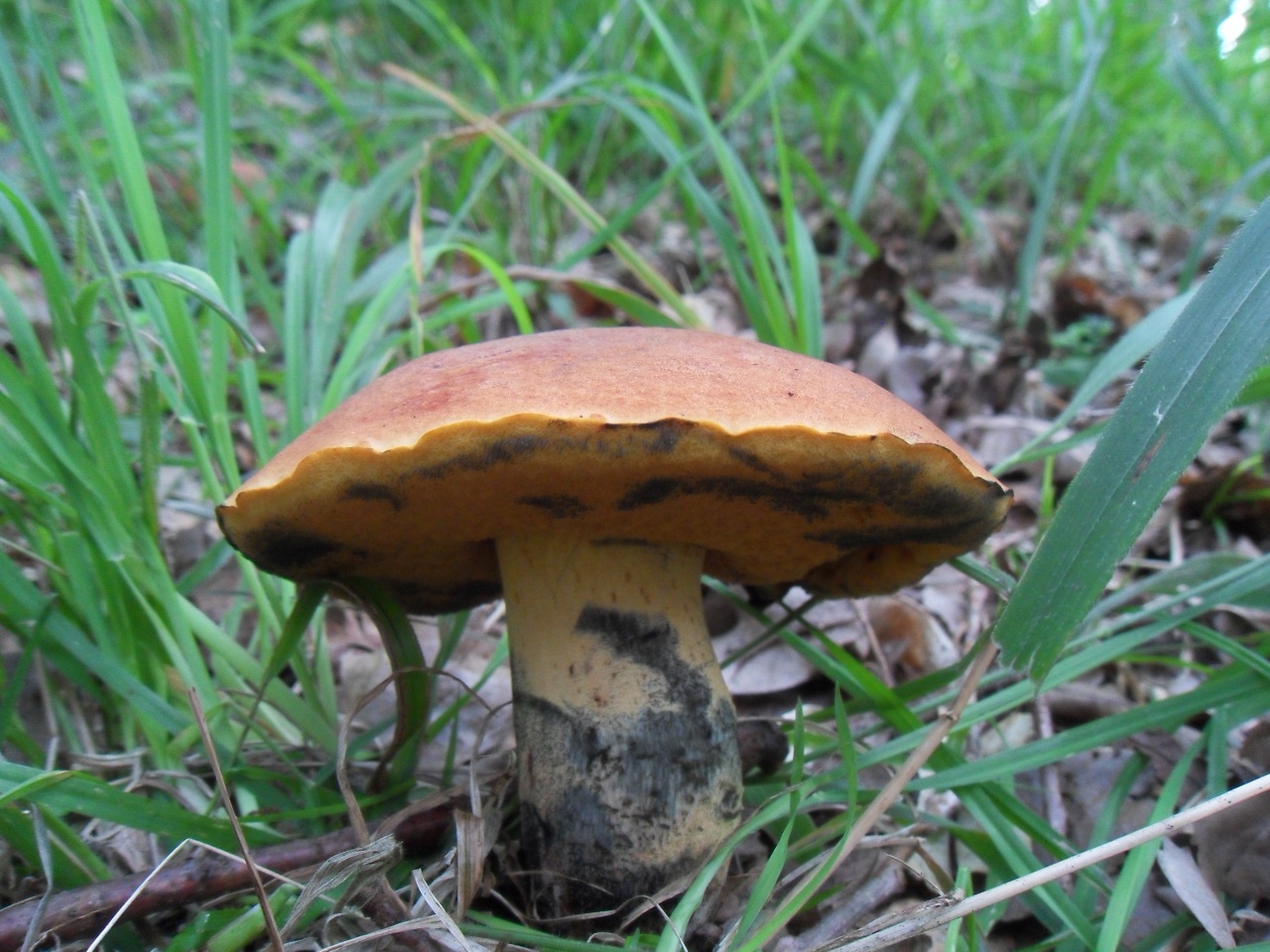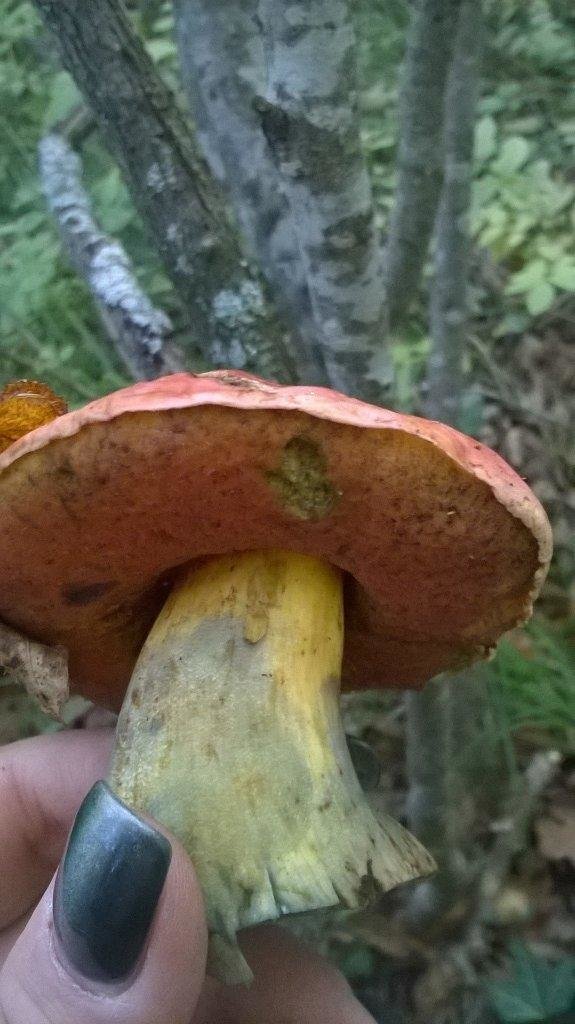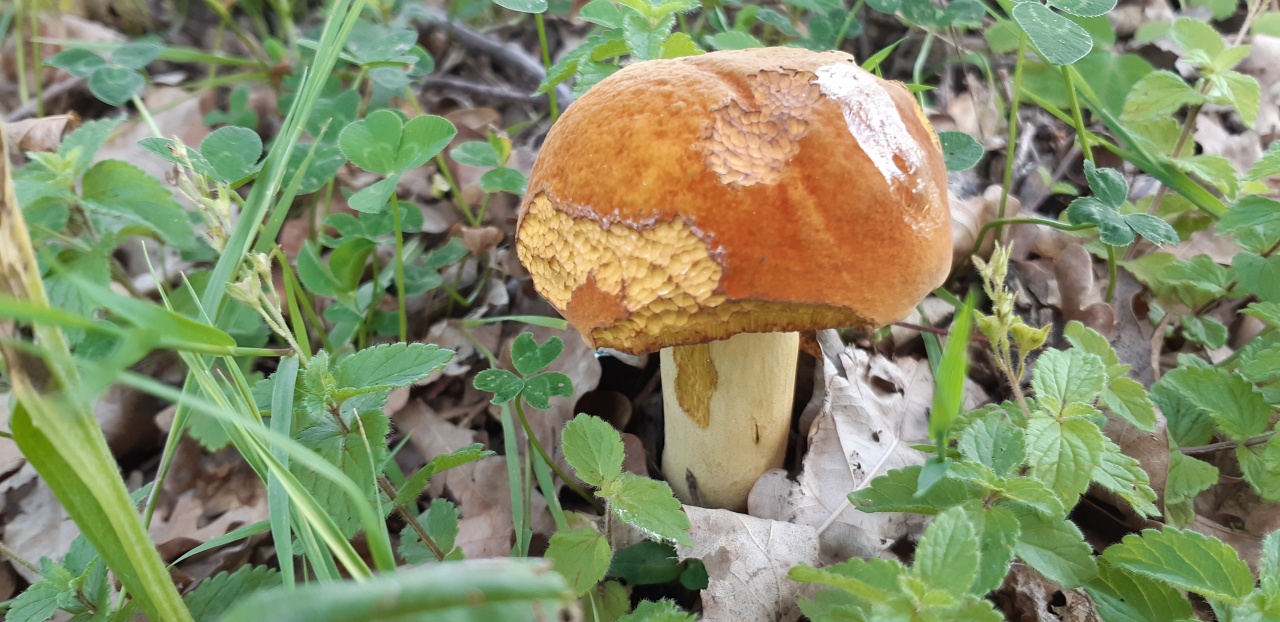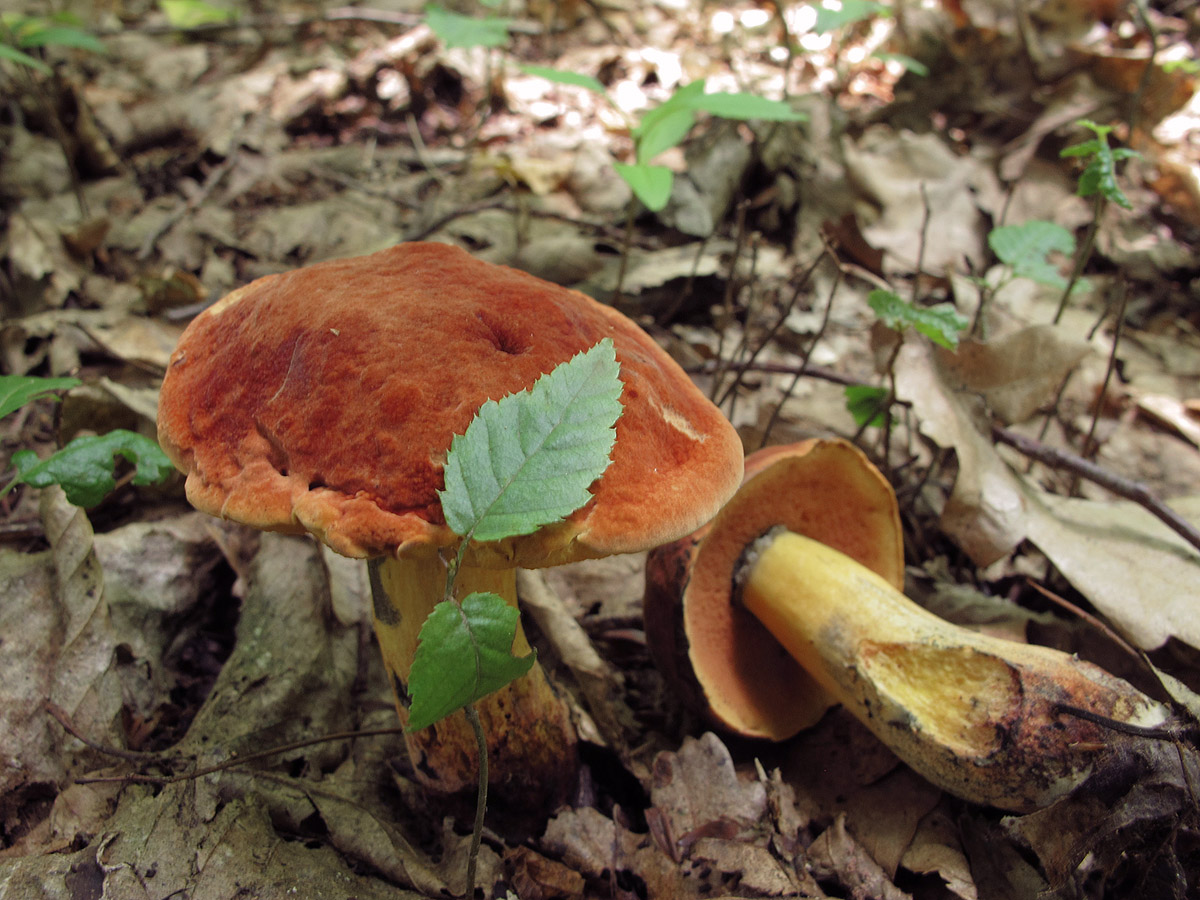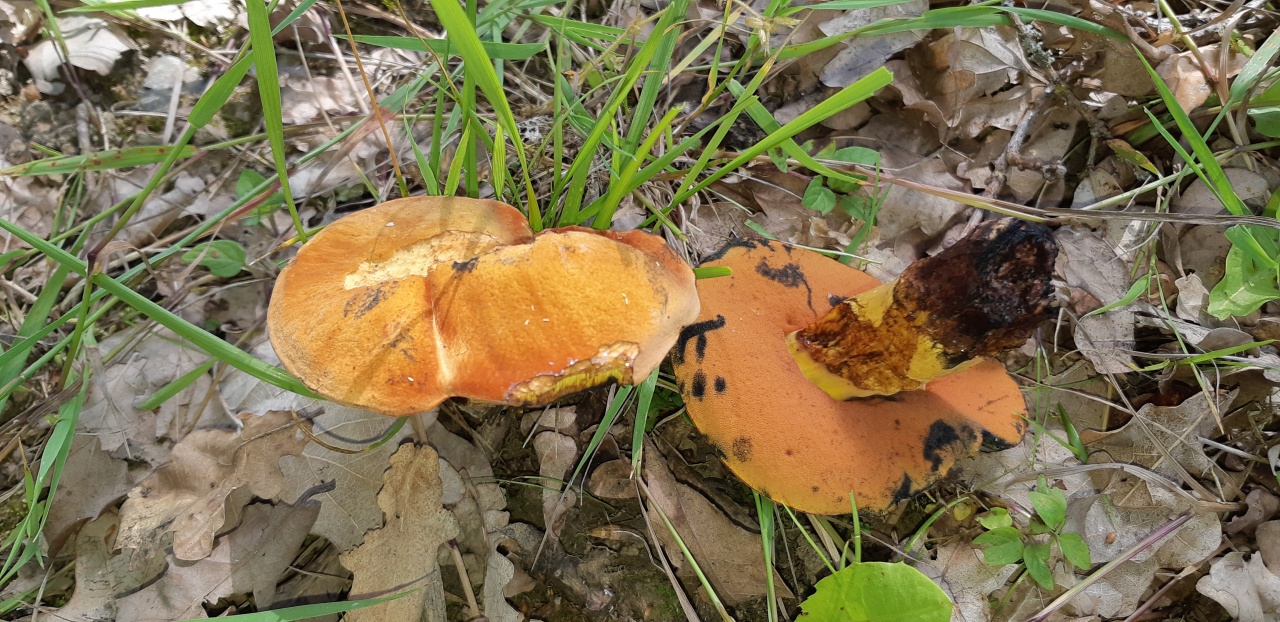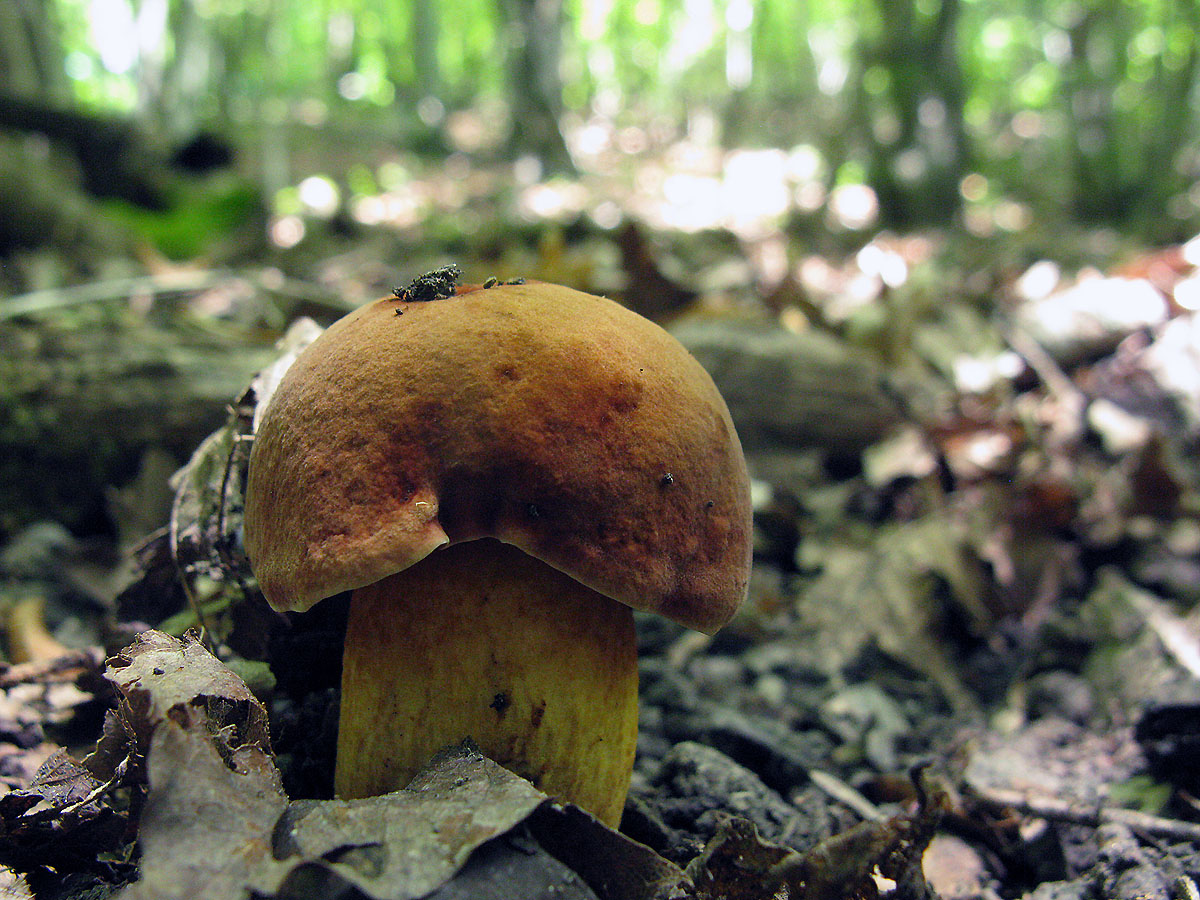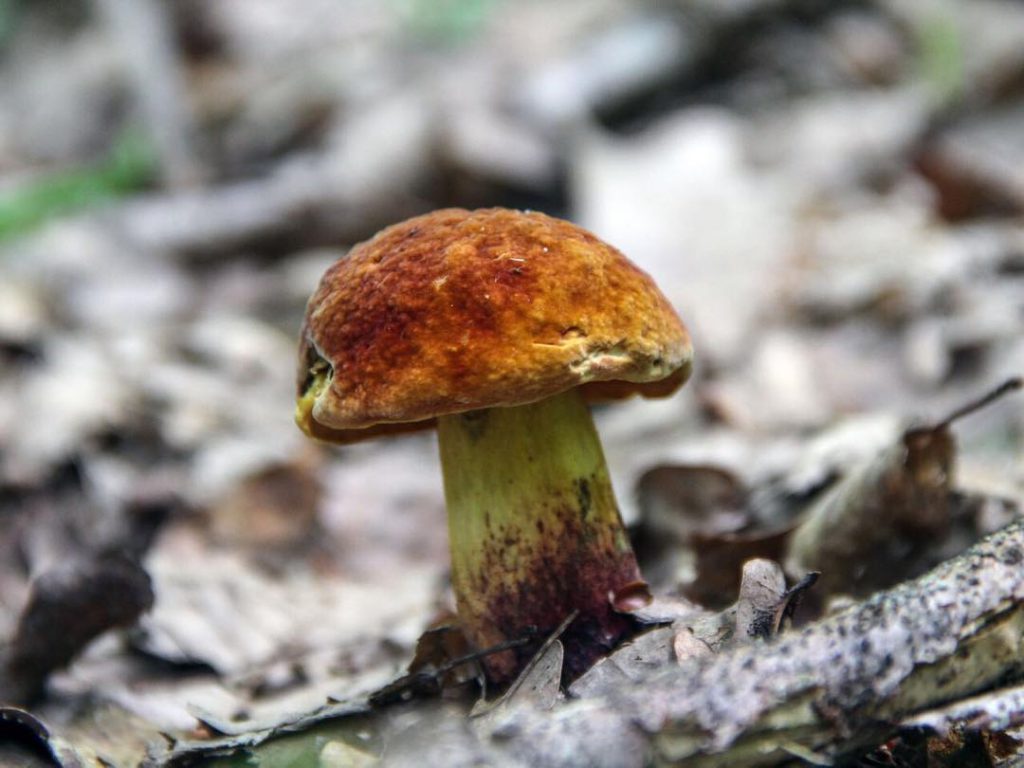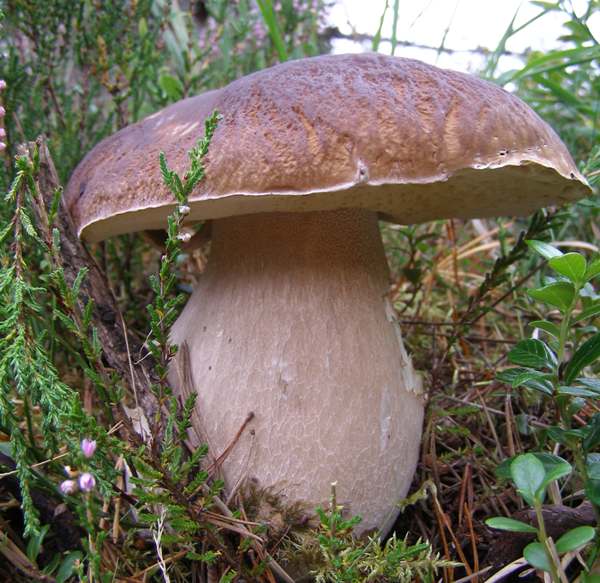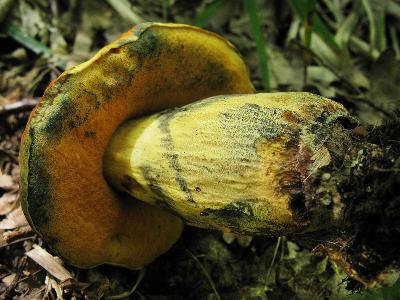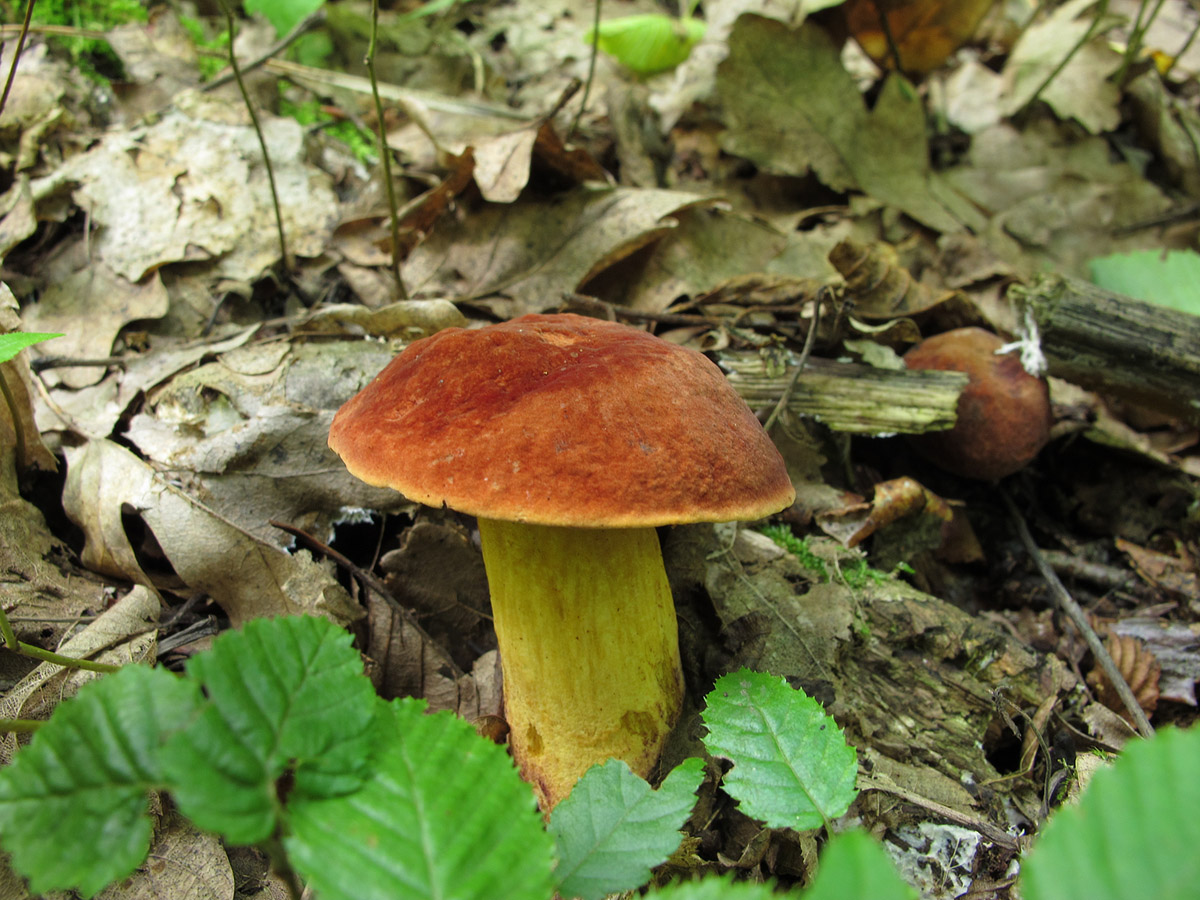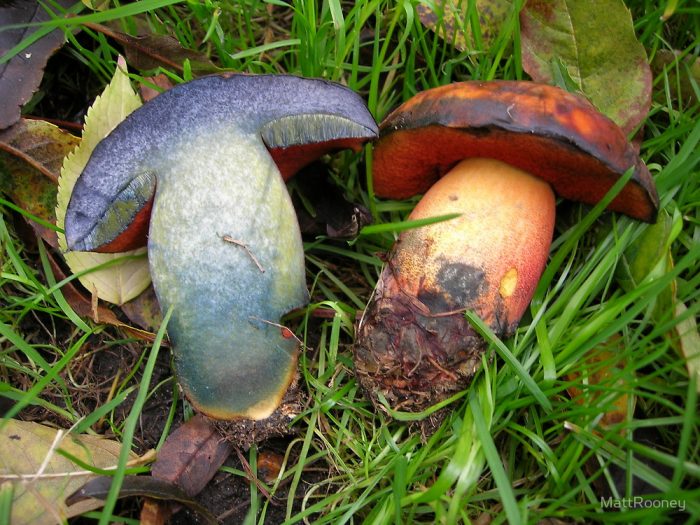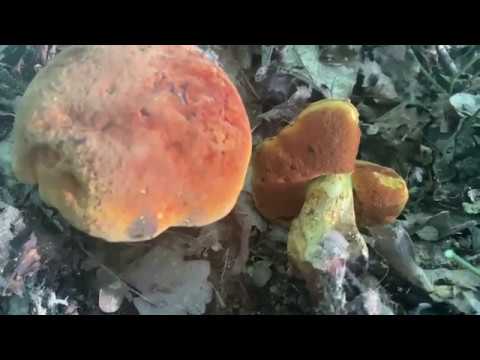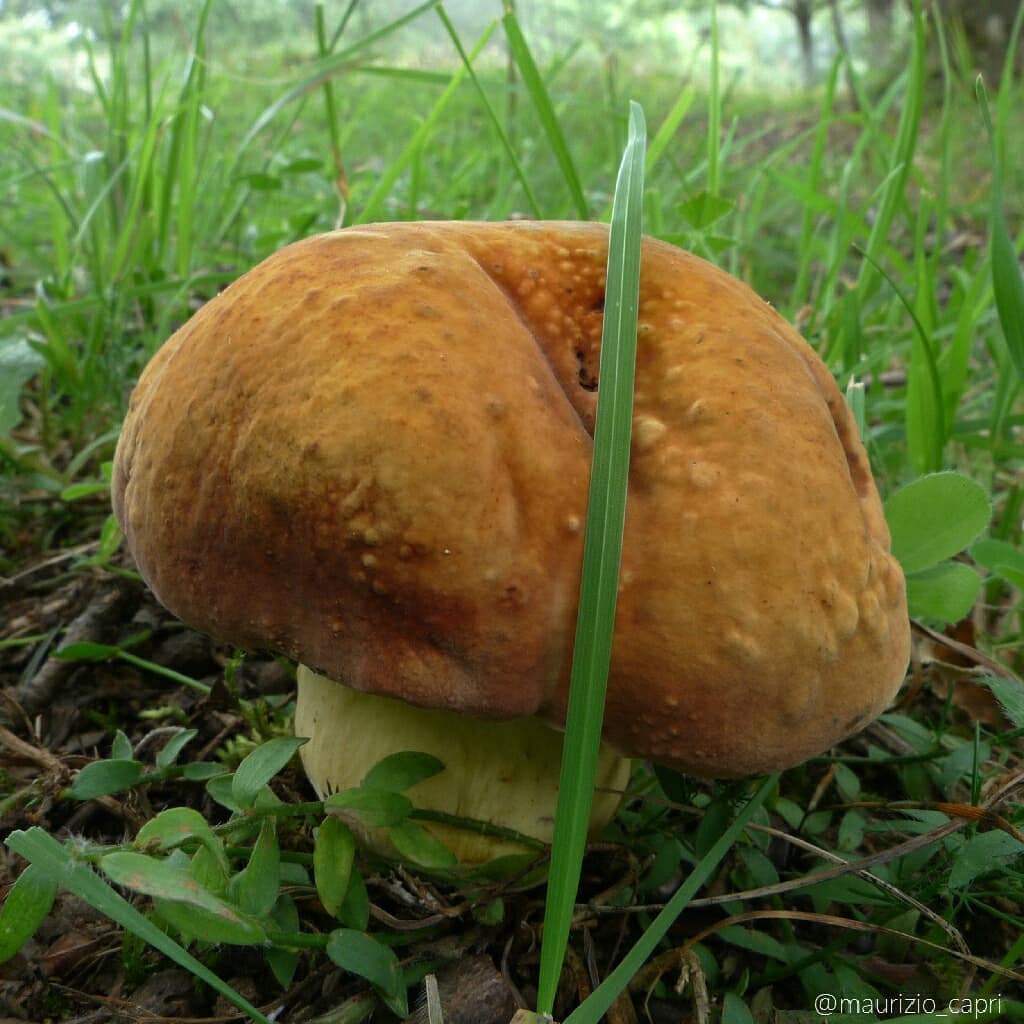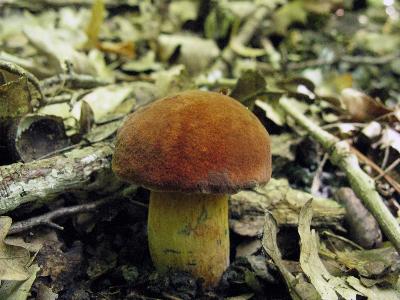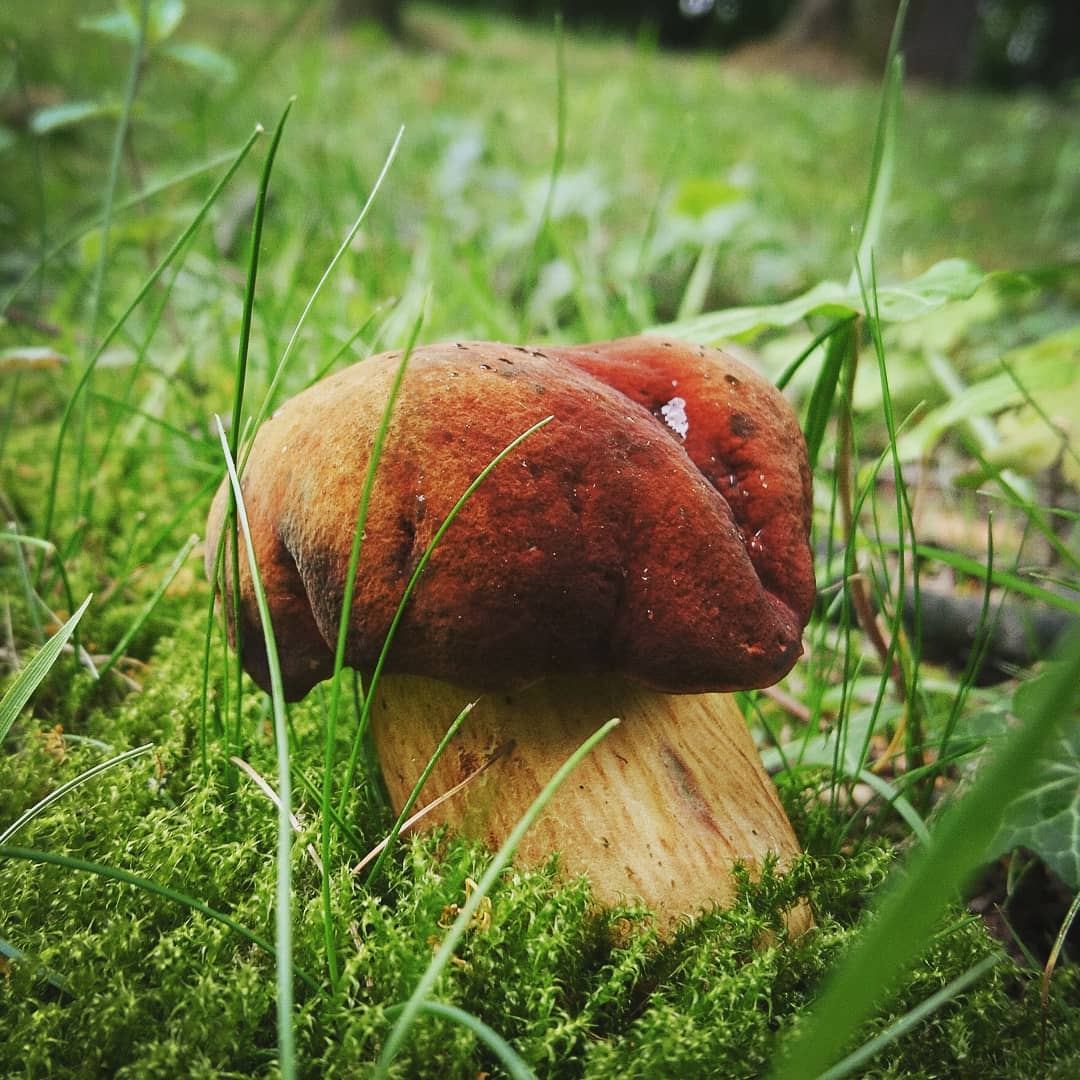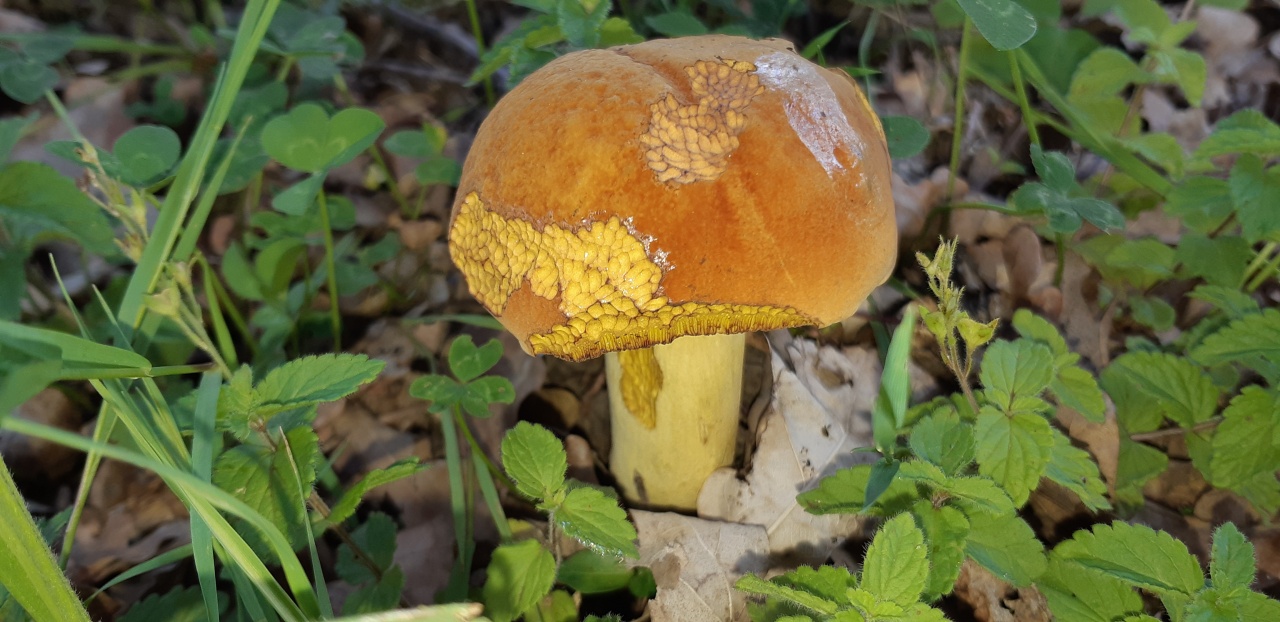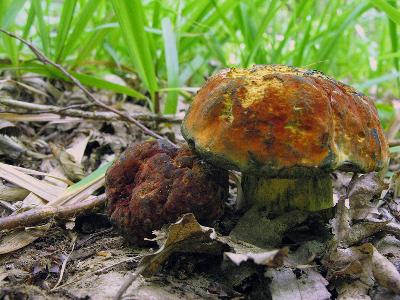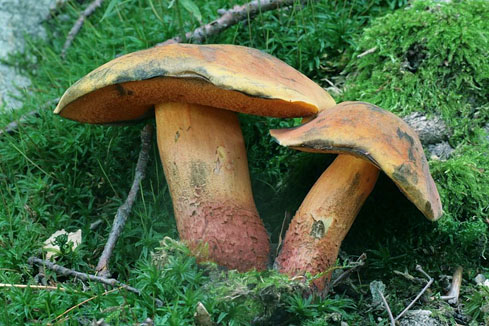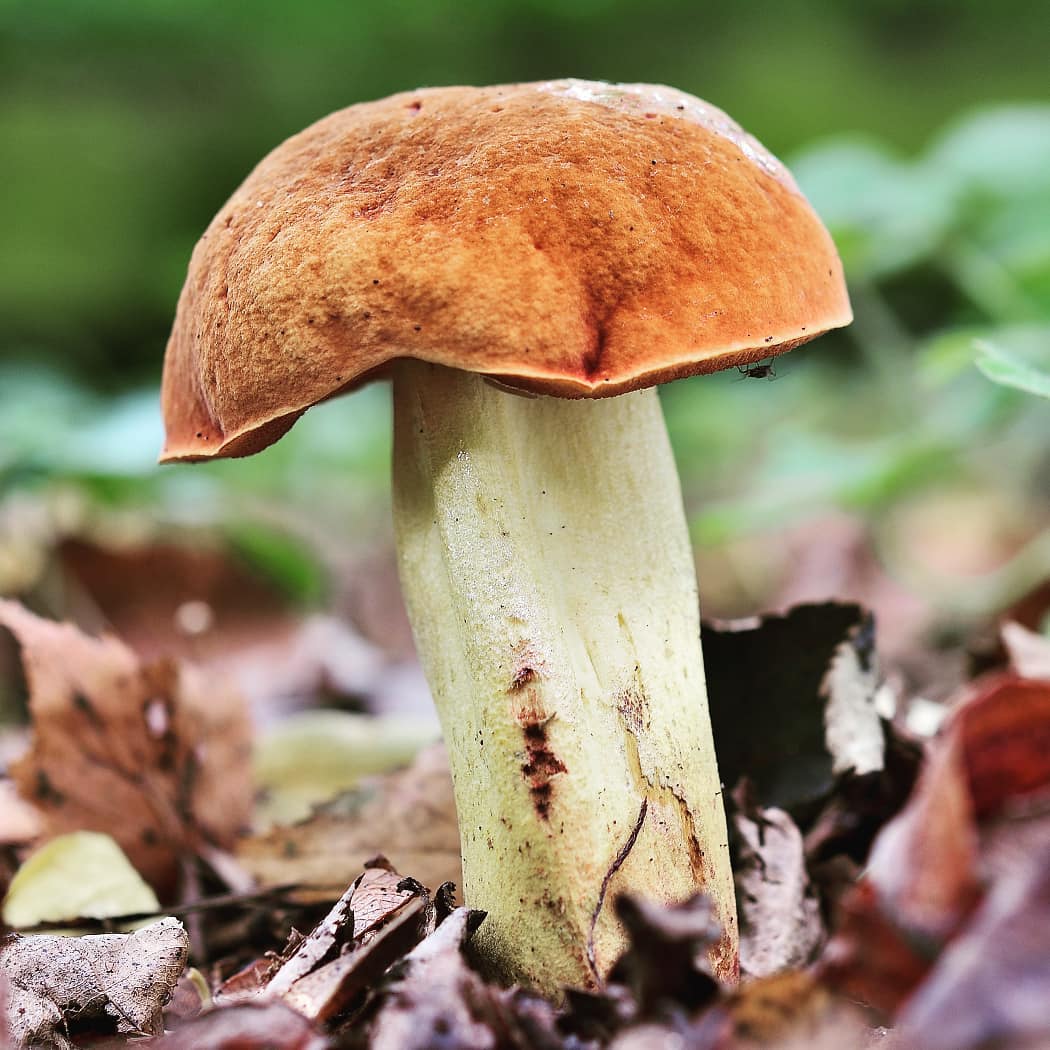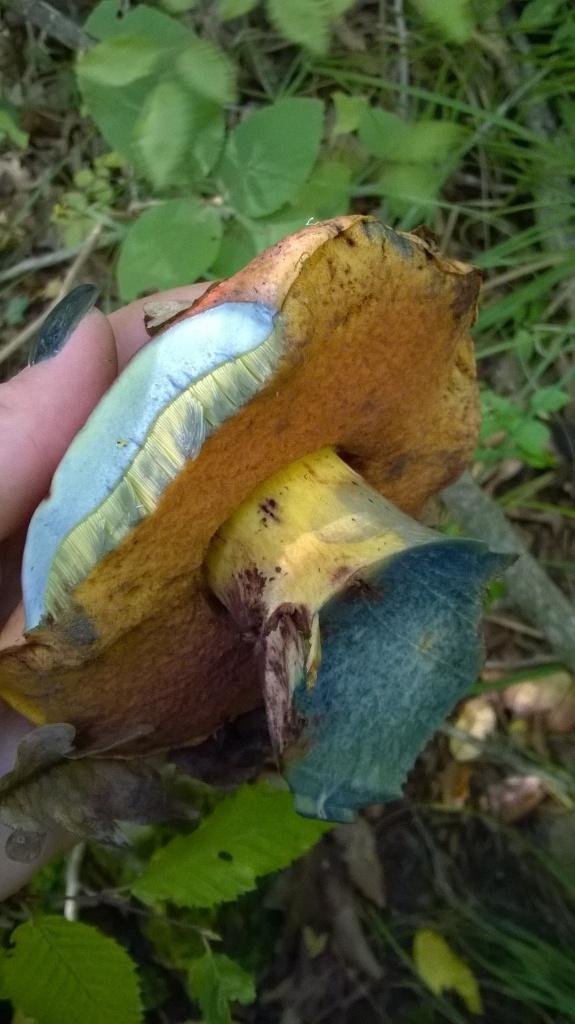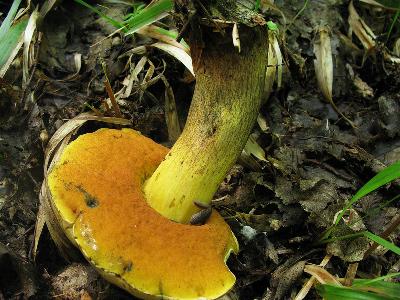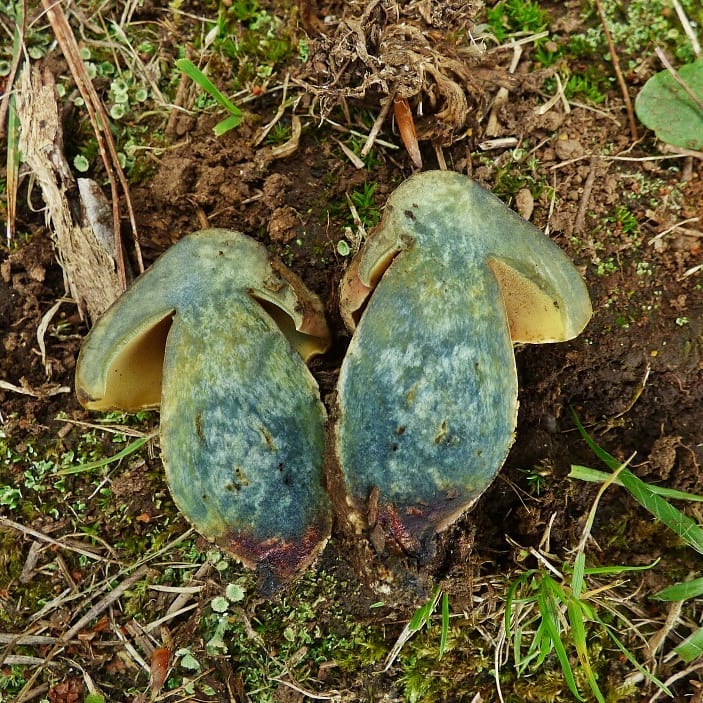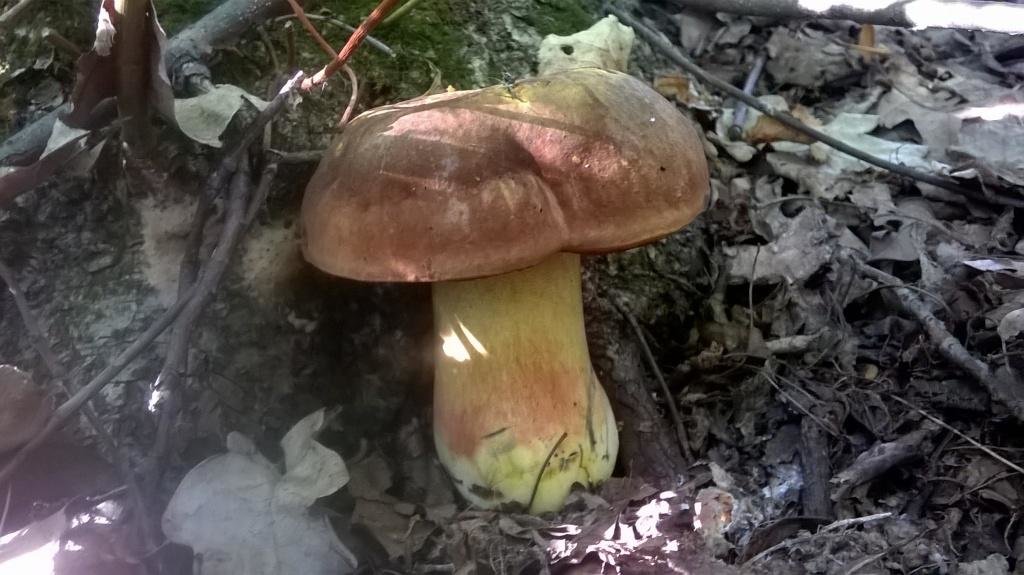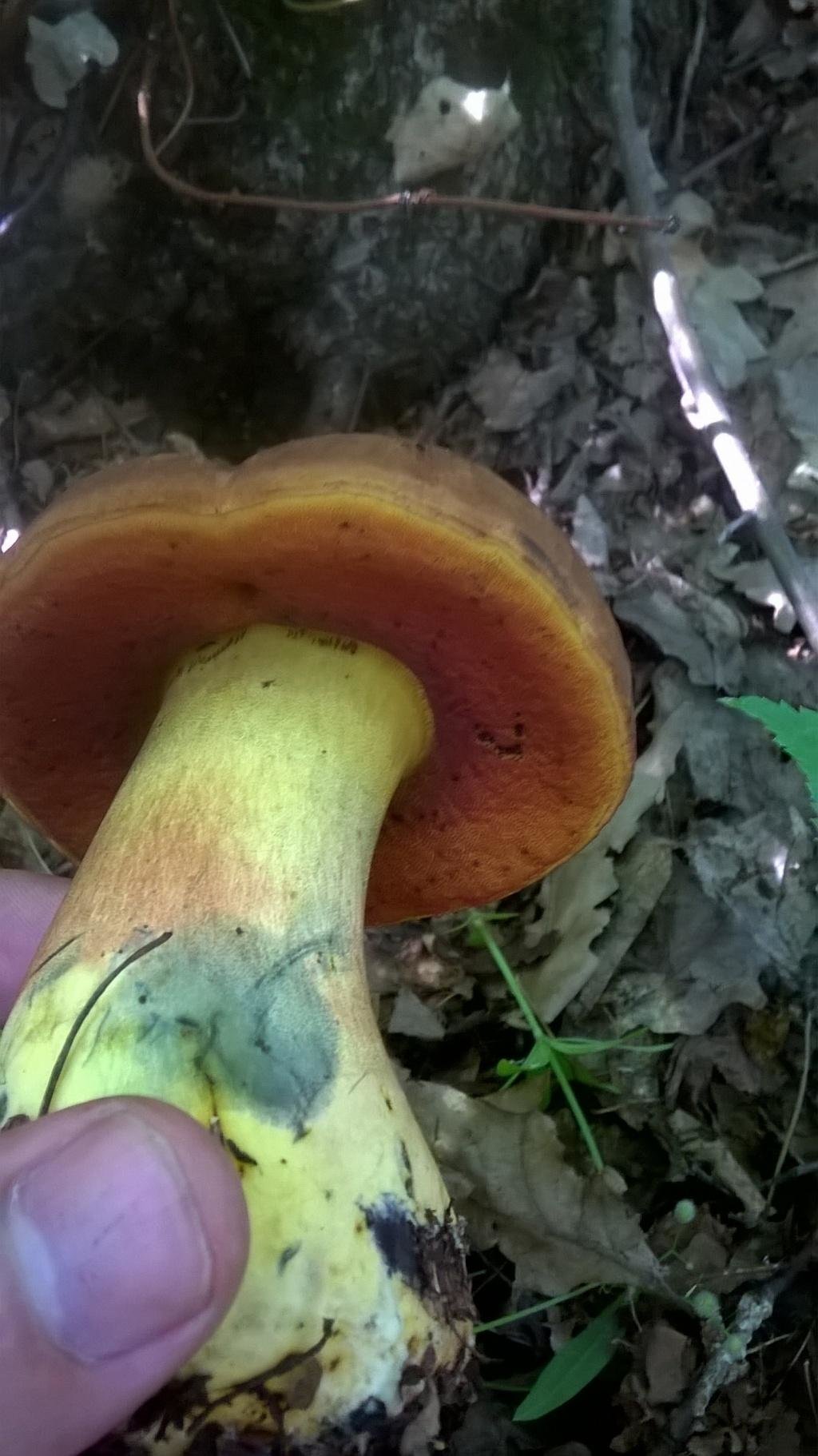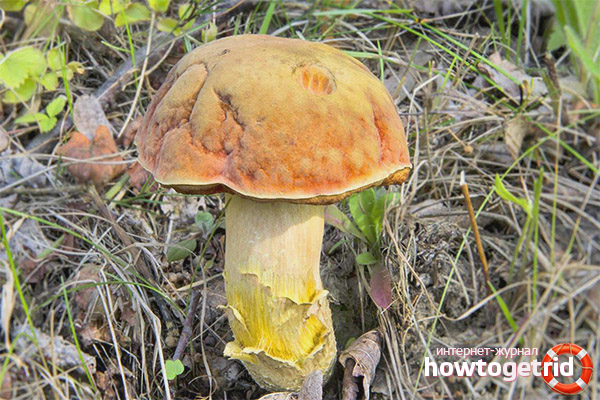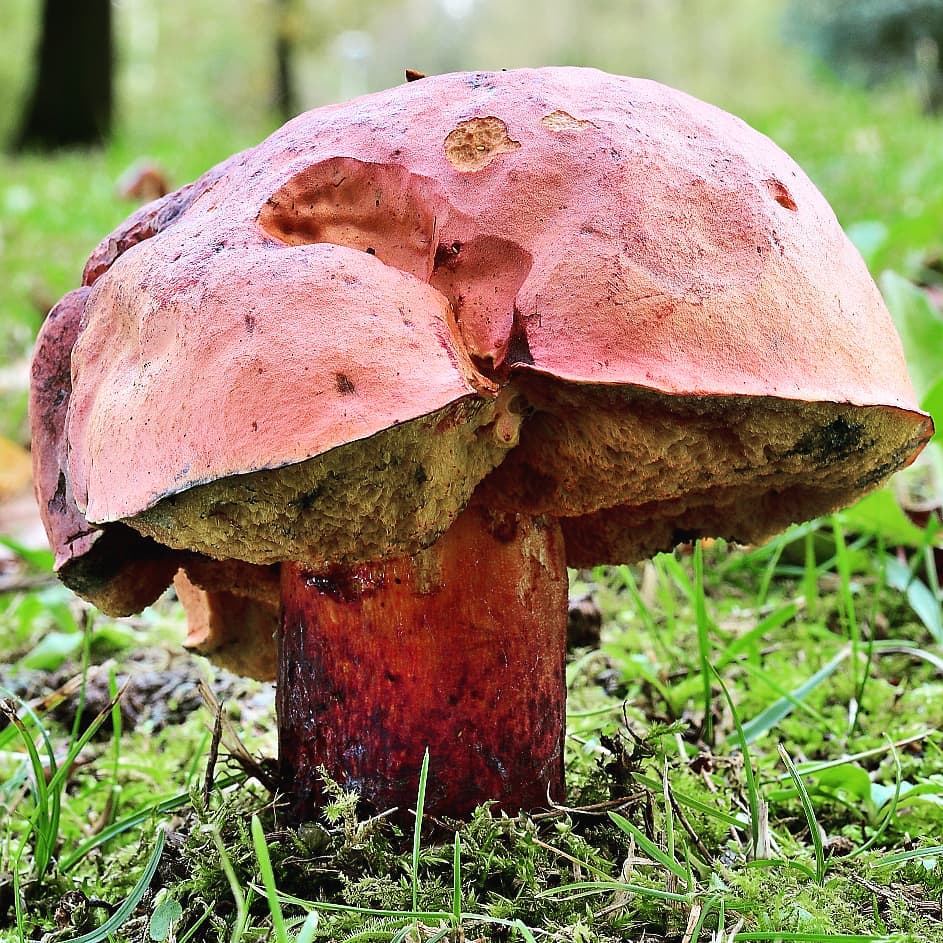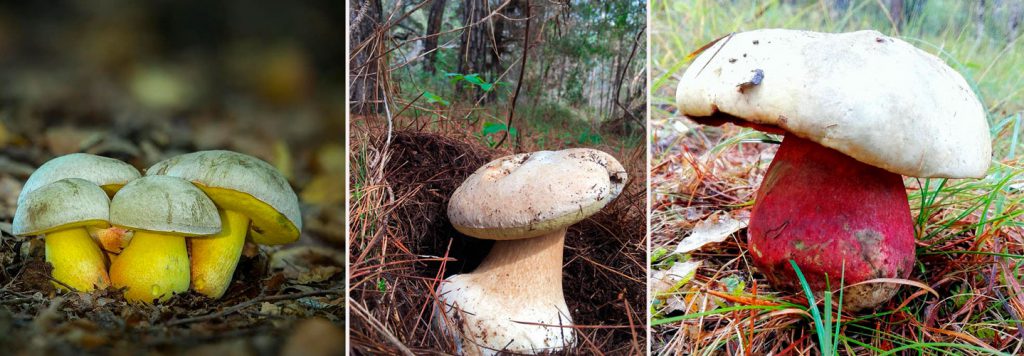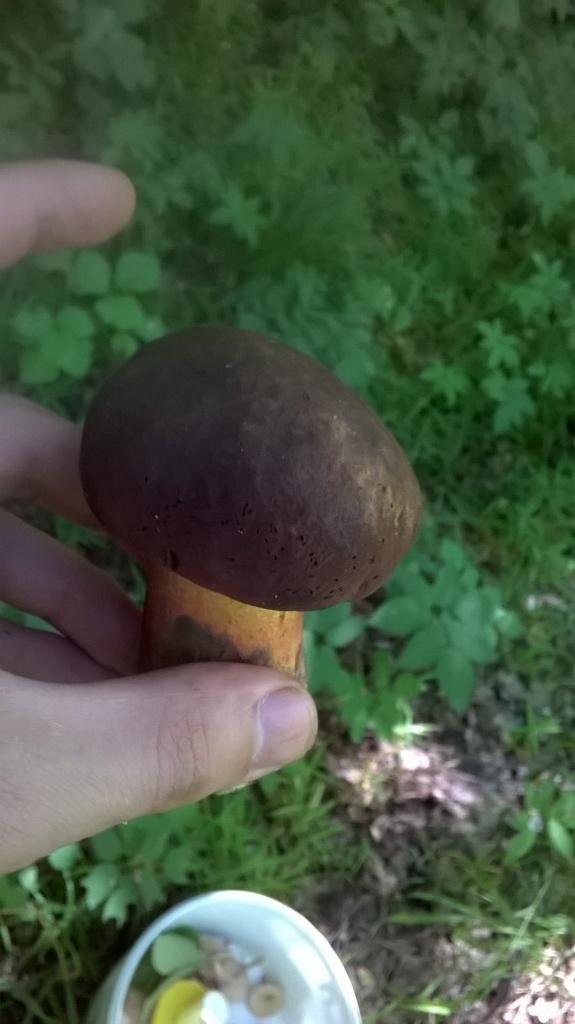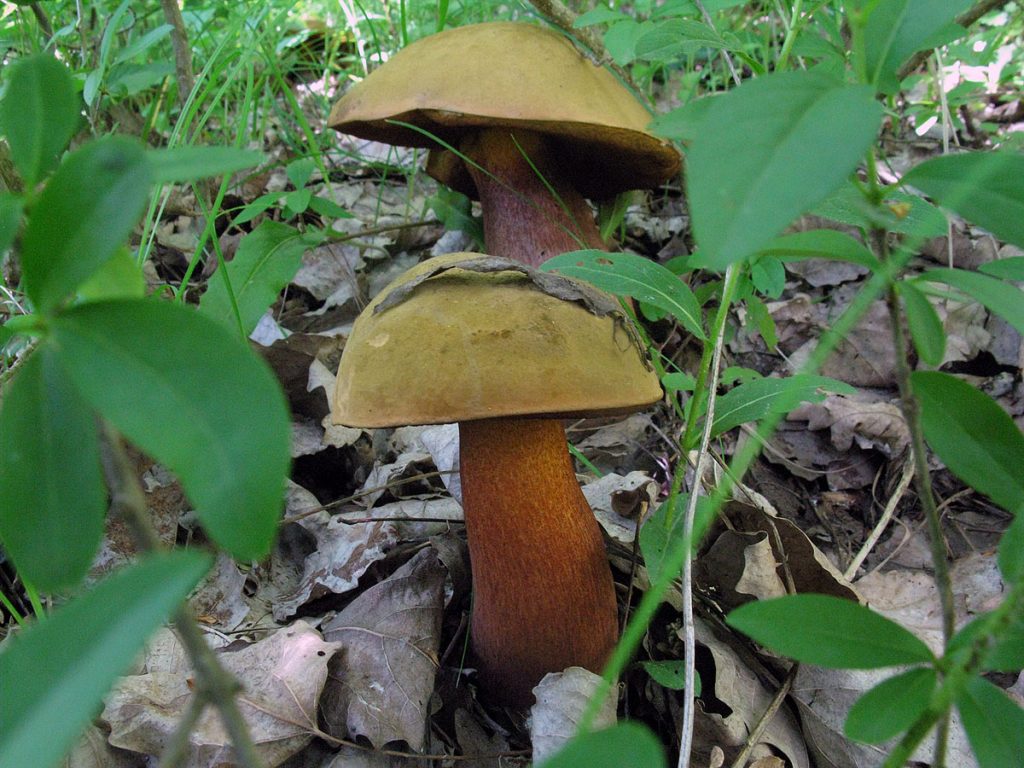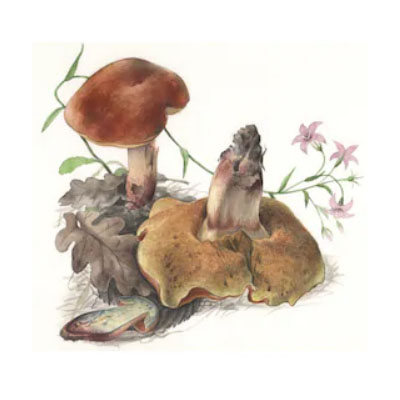The use of poddubovik in cooking
In principle, podduboviki mushrooms are edible, but they cannot be consumed in their raw form. Poorly cooked mushrooms can cause intestinal upset. Symptoms of the disease will appear fairly quickly (0.5-2 hours after consumption). Poisoning is accompanied by diarrhea, vomiting, fever, stomach pain.
With proper treatment, complete healing occurs in two days. If the mushroom is prepared according to the technology (with preliminary boiling with a decoction drain), then it has excellent taste and even tastes a little like a porcini mushroom. It can be used both for preparing daily meals and for canning.
Description and features of Dubovik. What does a mushroom look like?
The mushroom itself is tasty, has a pleasant aroma, but it is important not to confuse it with other, less tasty and less useful mushrooms. To do this, you should familiarize yourself with its appearance.
The hat has a large diameter that can reach 20 centimeters. The hat is massive, fleshy, hemispheric shape. It is practically not attached to the leg, we can say that it is worn on it. Over time, it opens up and becomes like a pillow. The top is velvety, with different colors: yellow-brown, gray-brown, dark orange. The cap is colored unevenly. The pulp is yellow, and at the place of the break it acquires a blue-green color.
The leg is rather thick, massive, clavate, up to 12 centimeters high. Under the cap, the leg has a yellow color, and the lower, the darker the color and at the very root it is dark orange. A distinctive feature of the mushroom is the mesh that covers the stem, the flesh is red.
The pulp is yellow, with strong pressure or when interacting with air in a cut form, it turns blue. The taste and aroma are pleasant, but not pronounced.
Varieties
The common oak tree also has varieties that are identical in composition to the original, but have a different appearance and size.
Speckled oak
Speckled oak is an edible mushroom with a pleasant taste and aroma.
The hat is velvety, it can be brown, dark blue, chestnut or brown, which darkens with the slightest pressure on the flesh. The shape is cushion or hemispherical.
The leg reaches 16 centimeters in height and has a red-yellow tint covered with dots or a kind of mesh.
The pulp is bright yellow or orange; at the place of a break or cut, it acquires a bluish tint over time. There is no strong taste and aroma.
Doubles. Satanic mushroom (poisonous), at the site of the break, the flesh turns red and only after that it acquires a bluish tint. The yellow boletus differs in that the mushroom has a completely yellow leg and can only be found in Western Europe. Oak Kele is a very rare type of fungus that grows only on limestone soil.
When and where can you meet? The mushroom grows from May to October:
- in Siberia;
- in the Caucasus;
- Far East;
- European part of Russia.
Sometimes found in Leningrad. In coniferous and deciduous forests, on marshy and acidic soils near spruce, fir and oak.
Olive brown
An edible mushroom belonging to the boletus genus, the taste and aroma are not pronounced.
The hat is convex, 20 centimeters in diameter, rarely flat. The color is brown with an olive tint, sometimes there is a yellow-brown tint. The edges of the hat are reddish, the bottom of its tubular burgundy color.
The leg is 12 centimeters high, the color is the same as that of the cap.
The pulp is fleshy, turns green at the fracture site. Has a pleasant, not pronounced taste and aroma.
When and where can you meet? Most often, the olive-brown poddubovik is found in deciduous and mixed forests in the lowlands. It mainly grows next to or under an oak tree, which is where this name comes from.It grows from July to September.
Types and their description with photo
Very often the oak tree can be confused with its subspecies, which include the common oak tree, speckled and Kele. The subspecies are similar in appearance and place of growth. Also, all species have the same yield period. A brief description of each species and photos are presented below.
Common Dubovik (Boletus luridus)
This subspecies is considered the most common. It belongs to the thermophilic species, therefore it is widespread in the south of Europe. It has a yellow tint, irregular in texture. The pulp is yellow, homogeneous, dense, when pressed or cut quickly turns blue, and later becomes black.



The leg is massive, tall, dark with a red tint, often covered with a dark mesh. With the trees under which it often grows, it often forms mycorrhiza. The tubular part of the cap has a golden hue and turns red as the subductor matures.
In an adult oak tree, the tubular part has an olive color, in connection with which it is also called an olive-brown oak tree. This type is widely used in cooking for cooking dishes and sauces.
Speckled oak (Boletus erythropus)
The second name of this type is a bruise or bruise. It differs from the previous representative in smaller size. His hat is brown, velvety in texture, and it also has a peculiarity - it darkens when pressed. The tubular part is red, and at the edges with a yellowish tint. When pressed, it instantly turns blue.



The stem is thinner, red in color with olive grain at the bottom. The pulp is light yellow in color and darkens sharply when pressed. Most often it can be found in oak groves, rich in humus. Yields peak in September. Speckled oak is a conditionally edible type, therefore it requires heat treatment before cooking.
Kele's Dubovik (Boletus queletii)
The main feature of this subspecies is that it is inedible, and when fresh, it is poisonous to humans. Dubovik Kele was named after the French scientist-mycologist, the founder of the society of mycologists. Kele has distinctive features in appearance, which helps not only experienced but also novice mushroom pickers to distinguish it from other oak trees:
- He has an olive-colored hat, velvet or suede in texture, which later changes and becomes smooth.
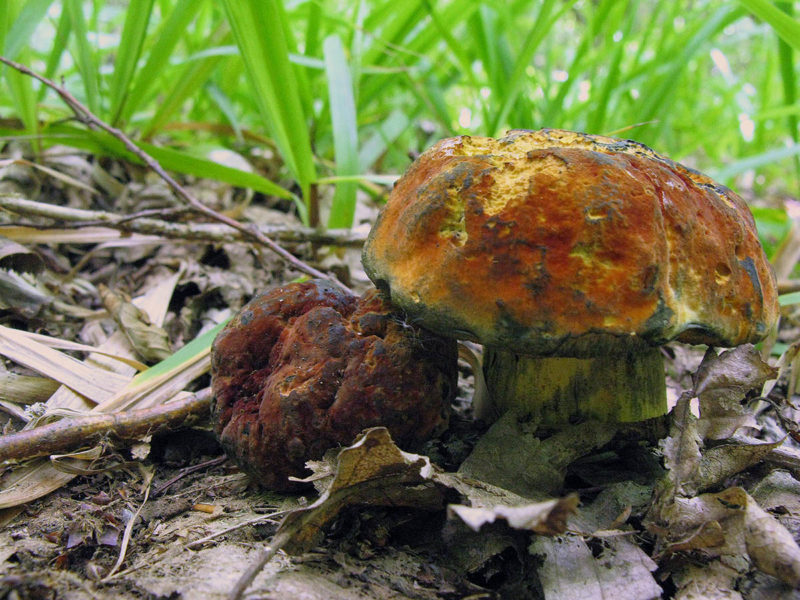
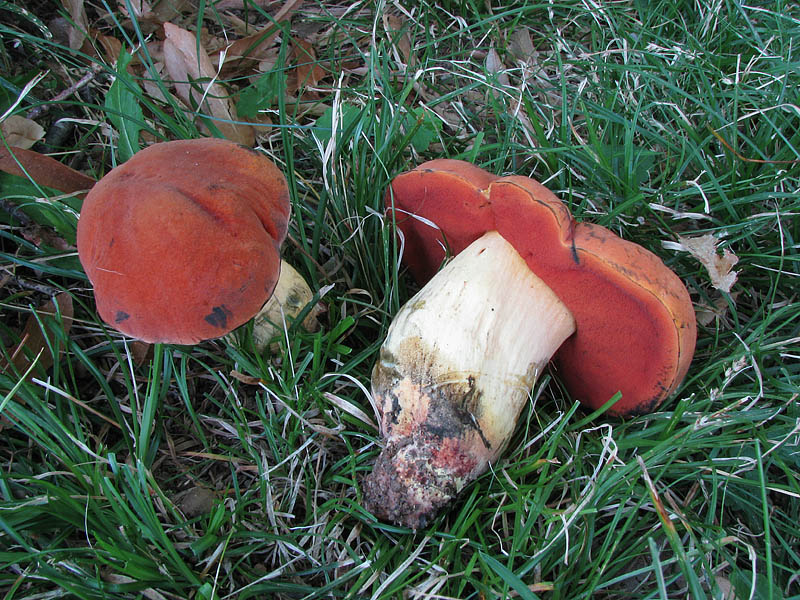
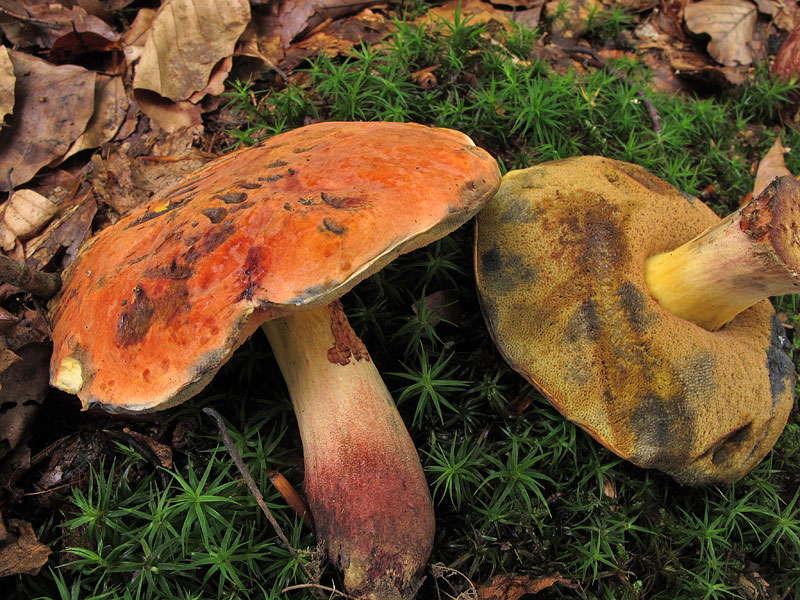
Satanic Poisonous Mushroom
The Satanic Mushroom is a dangerous poisonous mushroom, the consumption of which can lead to the death of a person. Inexperienced mushroom pickers may confuse the satanic mushroom with the oak tree, which is due to the similar appearance of these two representatives.
 Satanic mushroom
Satanic mushroom
Despite this, there are some signs by which they can be distinguished from each other.
| Criteria | Dubovik | Satanic mushroom |
|---|---|---|
| Hat | Olive, dark olive, brown with a red tint | Brown-yellow |
| Pulp | Yellow, turns blue quickly after incision | When cut immediately turns red, gradually becomes light |
| Leg | Yellow, with red mesh and grain | Yellow, red mesh only in the middle |
| Smell | Pleasant, hardly felt | Unpleasant |
Benefits and useful values of Dubovik
All edible mushrooms contain many beneficial acids, vitamins and minerals. The common oak mushroom does not lag behind the rest and also has many useful substances. The main components are zinc, magnesium and iron, which have reducing properties and other useful substances.
Zinc is beneficial for the proper functioning of the gastrointestinal tract. This microelement is able to accumulate in the pancreas, takes part in the work of digestion, and helps to properly assimilate nutrients.
Copper - restores cells, improves metabolism, forms hormones and improves blood circulation.
Iron - normalizes the amount of hemoglobin in the blood.The systematic intake of Dubovik, even in minimal quantities, replenishes the body's need for important components.
Amino acids - can improve mental and visual memory, add energy, vigor and strength, increase mental activity, and also prevent the development of atherosclerosis.
Beta-glucans - contained in large quantities of oak trees have a positive effect on the human immune system.
Distribution locations
The appearance of the common oak mushroom, conditions and places of distribution, when to collect. Distinctive features of similar species of mushrooms. Procurement methods.
The common oak mushroom (olive-brown) can be attributed to the rare and therefore desirable trophies of the "quiet hunt".
Less well-known than, for example, a boletus or a volnushka, but in no way inferior to them in nutritional value and rightfully deserves a place in the list of delicious, healthy mushrooms.
Description
The common oak tree (Boletus luridus) is classified as belonging to the class Agaricomycetes, the Boletaceae family. Other names:
- olive-brown oak;
- bruise;
- the boletus is dirty brown;
- poddubnik.

- The main part of the fruiting body, the cap, is massive, up to 15-20 cm in diameter, at a young age it has a hemispherical shape, in the process of maturation it acquires more blurred outlines resembling a pillow. Its surface is velvety and dry to the touch. The color of the cuticle (skin) is from dark to greenish-brown shades.
- At the break, the lemon-yellow pulp turns blue intensely and quickly, has no pronounced smell and taste.
- The color of the tubular layer below is red-brown and greenish in cross-section. Free or loosely adhered to the stem of the tube turn blue when pressed. Spore powder of olive-brown color.
- The leg is up to 15 cm high, about 3 cm thick, has a convex-cylindrical shape, tapers towards the cap, and is quite dense. The leg under the cap is yellow-orange in color, covered with a brownish-red distinctly noticeable mesh, at the base it is reddish-brown.
Olive brown oak tree is thermophilic; it is rarely found in northern latitudes. Grows in isolation in spruce and birch tracts of the Far East and Siberia. In Europe and the Caucasus, it is found in oak forests, coniferous and mixed forests.
The main symbionts, in the presence of which the fungus root (mycorrhiza) is best formed, are oak, beech and linden. The mycelium develops well on calcareous and marshy soils, in places sufficiently illuminated and warmed by the sun. Mushrooms grow singly or form small groups.
The main growing season and the beginning of the harvest is considered to be July - the end of September. Most massively appear in August.
The most famous of them is the speckled oak tree (Boletus erythropus (Fr.) Secr.), Like the ordinary one, is included in the second quality category, conditionally edible. It is found mainly in deciduous forests, unlike its relative, it has a darker color of the cap, its convex shape is pronounced even in adulthood. The leg is pale yellow with reddish dots and stripes.
Oak Kele (Boletus queletii). This species belongs to inedible mushrooms. Moreover, when fresh, it is poisonous.
Therefore, it is important to know its distinctive features:
- suede to the touch, olive-colored hat at a young age becomes smooth over time, acquiring a chestnut shade, poorly separating from the leg;
- the leg is smooth, cream-colored, without mesh and specks, has a regular cylindrical shape, slightly blue on the cut;
- When pressed in orange or brick color, the tubular layer instantly acquires shades of blue when pressed.
Like any conditionally edible mushroom, common oak tree should be consumed only after preliminary soaking and boiling (water must be drained repeatedly to remove toxins).
After heat treatment, they are used as filling for pies and for preparing traditional dishes with mushrooms - hodgepodge, soufflé, cutlets, sauces, fried potatoes.
They are also suitable for blanks for future use: pickling, salting, drying.
Collected and prepared with knowledge of all these features, oak woods not only diversify the diet and make it more nutritious. They are a natural source of iron, calcium and zinc compounds: only 10 g of boiled mushrooms can fill the daily need for these microelements without the use of often questionable dietary and dietary supplements.
False doubles
Dirty-brown boletus can be easily confused with other species. Well, if they turn out to be boletus (porcini mushrooms), or yellow oak trees - they are edible, there will be no harm from them. But inedible and even poisonous species that carry danger can also be mistaken for the bolletus. Its difference from others can be seen in the photo. More detailed descriptions can be found in the table:
| Variety | Hat | Leg | Pulp | Category |
Speckled oak tree or Boletus erythropus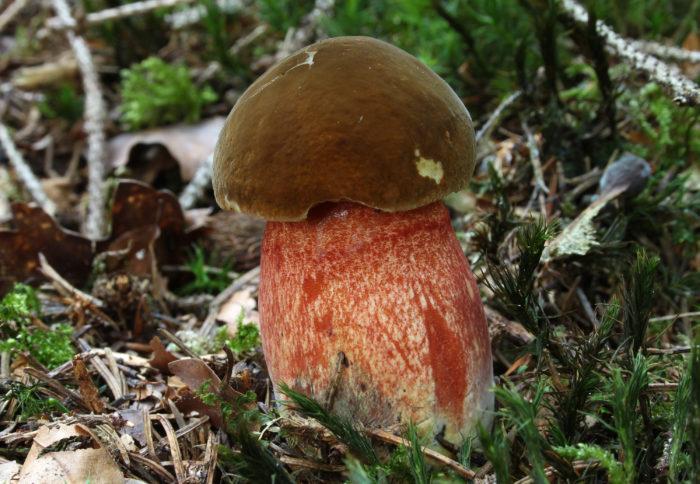 |
Hemispherical or convex, color - all shades of brown | Cylindrical, tuberous, yellow-red with speckled specks | White or yellowish, turns blue quickly, has no taste or smell | Conditionally edible |
Dubovik Kele or Boletus queletii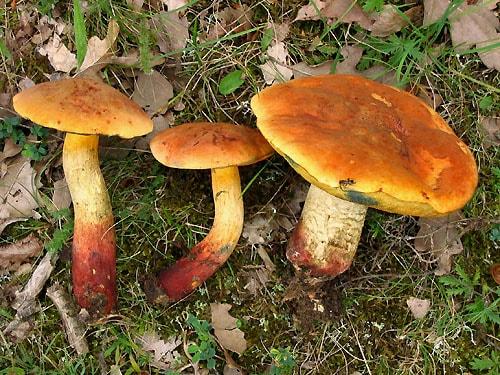 |
Has a rounded-convex shape, brown-chestnut color, velvety or smooth surface | Cylindrical, with a thickening at the base, without mesh, has a yellowish brown color | Fleshy, dense, yellowish, quickly turns blue, without a characteristic odor | Edible |
Satanic mushroom or Boletus satanas |
Hemispherical or rounded-cushion, smooth or velvety. Has a whitish or grayish color with an olive tint | Tuberous or barrel-shaped, dense, colored red | White or yellowish, turns blue or red when cut, has an unpleasant odor | Poisonous |
Polish mushroom or Xerocomus badius |
The cap is semicircular, cushion-shaped, sometimes flat. Color - chestnut brown, dark brown | Cylindrical or slightly tapered, fibrous, color - light brown | Fleshy, dense, slightly blue in the cap when cut, then becomes light again. Pleasant mushroom smell, mild taste. | Edible |
| White mushroom or
Boletus edulis |
The cap is cushion-shaped, from whitish to dark brown. the surface is smooth, slightly velvety | Very massive, solid, cylindrical, white or light brown | White, dense, thick, does not change color at a break, has no smell, but has a pleasant nutty taste | Edible |
Collection and application
Due to the high content of organic substances, oak wood is used for the manufacture of antibiotics and in folk medicine, and edible species collected in time are also used for the preparation of various hot dishes, pickles, as a component of seasonings.
When and how to collect correctly?
Mid-July is considered the beginning of the oak tree harvesting season. However, the peak yield occurs in early September. It grows mainly in clusters under trees, which makes it much easier to find. Mushroom picking begins early in the morning before they are heated in the sun (otherwise their shelf life will be significantly reduced).
Recipes and processing features
First of all, before cooking, the mushroom is kept in boiling water for 15-20 minutes. Then proceed directly to cooking. Eating raw mushrooms can lead to poisoning, which is manifested by acute dyspeptic disorders.
 Pickled oak wood
Pickled oak wood
Most often, oak wood is pickled or fried. The marinade is made from garlic, bay leaves, black pepper, dill, cloves, sugar and sea salt. For marinating, add all the ingredients in 200 ml of water and boil for 5 minutes, then put the mushrooms and boil the same amount. The boiled mushrooms are laid out in jars, vinegar is added to them, and the jars are carefully closed.
The recipe for fried mushrooms with potatoes is especially popular. To do this, the mushrooms are initially fried with onions and oil, after which potatoes are added. After frying, sour cream is added to the dish and baked in the oven.After cooking, you can sprinkle with herbs and garlic.
Useful properties and restrictions to use
In addition to cooking, oak wood is used in medicine for the preparation of the antibiotic bolitol. The pulp has immunostimulating properties. In its composition, the mushroom contains amino acids that improve memory, and also contribute to the prevention of atherosclerosis.
Useful properties of oak tree
In addition, eating helps to eliminate dyspeptic disorders and improves the performance of the digestive tract, reduces the amount of glucose in the blood. The beneficial substances of the poddubnik accelerate the metabolism, which leads to a decrease in body weight.
In folk medicine, tinctures were prepared from this type, which were taken in case of malaise and disorders of the nervous system. The mushroom contains proteins, fats, carbohydrates, vitamins A, C, B1 and B2, zinc, magnesium, ferum, manganese.
Views
| Olive brown oak (Suillellus luridus) | ||
|
The cap is 50–200 mm in diameter, in young fruiting bodies it is semicircular, velvety, matte. As it grows, it becomes cushion-shaped, naked. Skin color can be varied, olive-brown, yellowish, reddish, yellow-orange, when pressed, it turns blue, which turns brown. |
||
| Oak Kele (Suillellus queletii) | ||
|
The cap is 45–150 mm in diameter, in young fruiting bodies it is semicircular, velvety, matte. In adult mushrooms, it becomes cushion-shaped, almost prostrate, smooth. The skin does not separate from the flesh, the color can vary from pale chestnut to pink-orange. |
||
| Pink-skinned boletus (Suillellus rhodoxanthus) | ||
|
The cap is 55–200 mm in diameter, in small mushrooms it is velvety, semicircular, matte, yellow-ocher, brown-yellow. As the fruiting body grows, the cap becomes cushion-shaped, smooth, dry, dark ocher in color. The skin has a pinkish tint, turns brown when pressed. |
||
| Olive brown oak (Suillellus luridus) |
|
The cap is 50–200 mm in diameter, in young fruiting bodies it is semicircular, velvety, matte. As it grows, it becomes cushion-shaped, naked. Skin color can be varied, olive-brown, yellowish, reddish, yellow-orange, when pressed, it turns blue, which turns brown. |
| Oak Kele (Suillellus queletii) |
|
The cap is 45–150 mm in diameter, in young fruiting bodies it is semicircular, velvety, matte. In adult mushrooms, it becomes cushion-shaped, almost prostrate, smooth. The skin does not separate from the flesh, the color can vary from pale chestnut to pink-orange. |
| Pink-skinned boletus (Suillellus rhodoxanthus) |
|
The cap is 55–200 mm in diameter, in small mushrooms it is velvety, semicircular, matte, yellow-ocher, brown-yellow. As the fruiting body grows, the cap becomes cushion-shaped, smooth, dry, dark ocher in color. The skin has a pinkish tint, turns brown when pressed. |
If you are in doubt about the edibility of the mushrooms you find, do not take them. The site administration does not bear any responsibility for the actions of people taken on the basis of the information received on the site. Some types of poisonous mushrooms cannot be identified without special equipment and can be confused with edible ones.
Growing at home and in the country
Dirty-brown boletus is a mycorrhizal fungus, which means that it can be grown in a summer cottage, but provided that there is an oak or birch. The simplest, most effective and less costly way is to cultivate oak tree from ready-made mycelium. It can be purchased at specialized gardening stores.
The growing process in a summer cottage consists of the following stages:
- Choose a tree under which the mushrooms will grow. This should be a shaded area of 2.5–3 m².
- Dig a hole 30 cm deep and fill it with nutrient mixture.
- Line the bottom with 10 cm of foliage, grass or wood bark.
- Cover with dung or soil taken under the tree.
- Spread the mycelium evenly, which should be premixed with 1 kg of soil.
- Place fallen leaves on top.
- The last layer is garden soil.
- Moisturize with a drip method.
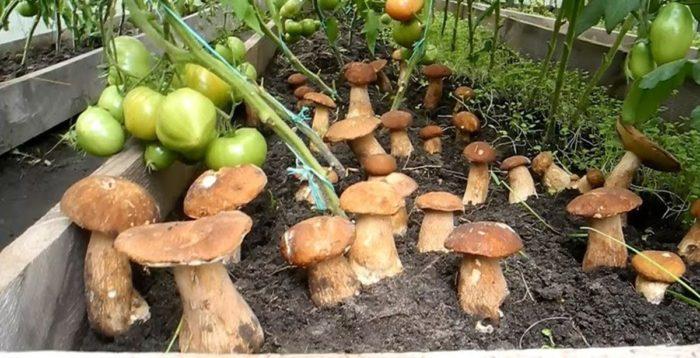 The first fruiting bodies will appear after 1–1.5 months, and then the crops will ripen every week. The fruiting period lasts from May to October. The mycelium lives up to 5 years.
The first fruiting bodies will appear after 1–1.5 months, and then the crops will ripen every week. The fruiting period lasts from May to October. The mycelium lives up to 5 years.
How to grow common oak tree indoors:
- Pour fertile soil mixed with mycelium into the boxes.
- Place containers in a well-ventilated place with direct sunlight. The room should have electric lighting 3-4 hours a day.
- Place containers of water near the drawers to maintain optimal humidity levels.
- Mushrooms grow at temperatures from 5 to 30 ºС (optimal - from 12 to 26).
Processing and application
In order to be able to eat the oak mushroom, it should be soaked for half a day, during which time it is necessary to change the water to clean water every 1-2 hours. Then they are boiled and only after that it can be cooked according to the recipe you like. Although there are few toxins in this mushroom, they are still destroyed during cooking. Failure to properly handle mushrooms can lead to gastrointestinal problems.
Also, the oak tree can be boiled first, then fried, seasoned with your favorite sauce. In addition, soups, sauces, dressings are made on the basis of mushrooms in addition to garnishes. Even during heat treatment, oak wood does not lose its value, smells good and has good taste.
Medical value
In folk medicine, Duboviks became famous as a medicine against malignant tumors. For a long time, lotions and balms have been made from these mushrooms, when applied, fatigue decreases, depression disappears, nerves calm down and fatigue disappears.
Olive brown oak tree (Latin Suillellus luridus)
Name Olive brown oak tree.Latin name: Suillellus luridus.Other names: Common Dubovik, Poddubnik, Dirty-brown Bolette.Department: Basidiomycota.Class: Agaricomycetes.Order: Boletovye.Family: Boletovye.Genus: Suillellus.Conditionally edible mushroom.
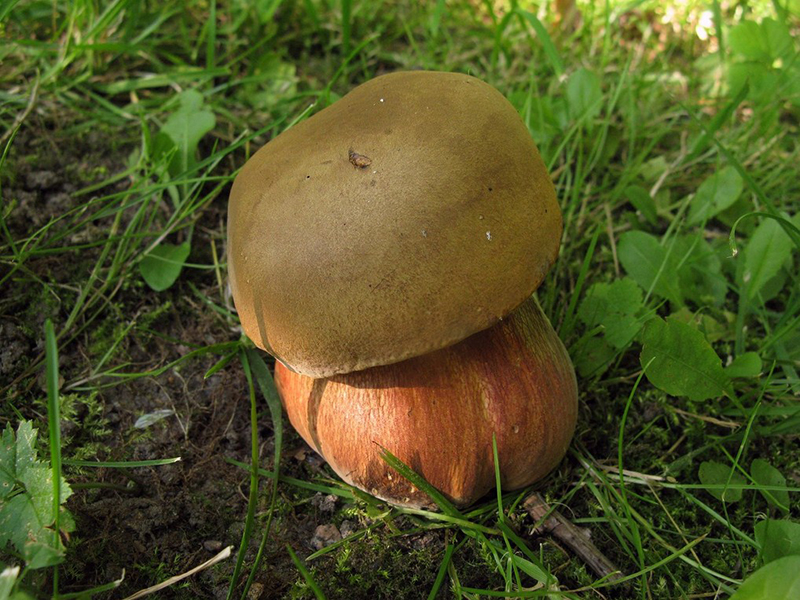 Name Olive brown oak tree.Latin name: Suillellus luridus.Other names: Common Dubovik, Poddubnik, Dirty-brown Bolette.Department: Basidiomycota.Class: Agaricomycetes.Order: Boletovye.Family: Boletovye.Genus: Suillellus.Conditionally edible mushroom.
Name Olive brown oak tree.Latin name: Suillellus luridus.Other names: Common Dubovik, Poddubnik, Dirty-brown Bolette.Department: Basidiomycota.Class: Agaricomycetes.Order: Boletovye.Family: Boletovye.Genus: Suillellus.Conditionally edible mushroom.
Leg
35–155 mm in height, 22–50 mm in thickness, not hollow, at first barrel-shaped, then clavate or cylindrical, yellow with a pronounced reticular pattern. The pattern has elongated cells of a rather large size, the color is bright red, noticeably darker at the base of the stem.
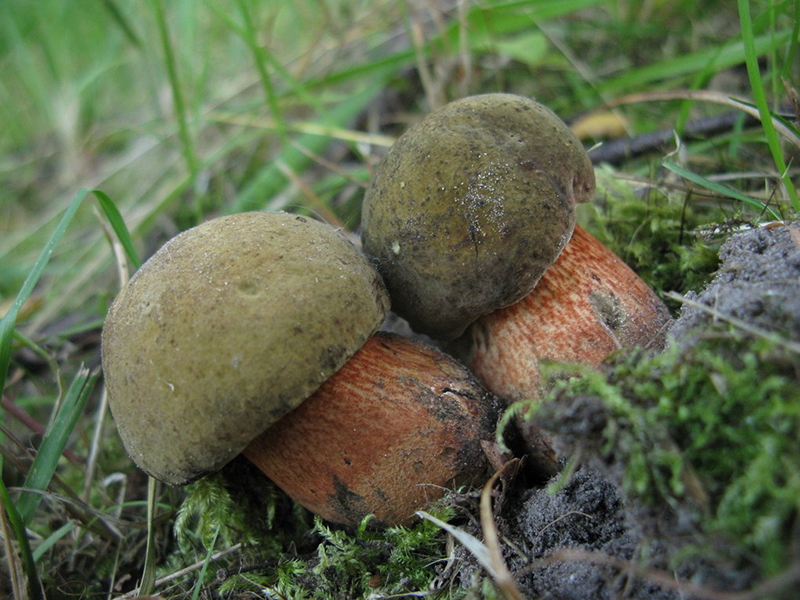
Hat
50-200 mm in diameter, in young fruiting bodies it is semicircular, velvety, dull. As it grows, it becomes cushion-shaped, naked. Skin color can be varied, olive-brown, yellowish, reddish, yellow-orange, when pressed, it turns blue, which turns brown.
Hymenophore
Tubular, notched at the stem, tubules 14–30 mm long, yellow in young mushrooms, then olive, turn blue on cut. The pores are rounded, at first yellow, then turn orange, reddish, brick-red.
Pulp
Dense, yellow, wine-red at the base of the stem, on the cut the yellow part of the pulp acquires blue and green shades. The taste and smell are not expressive.
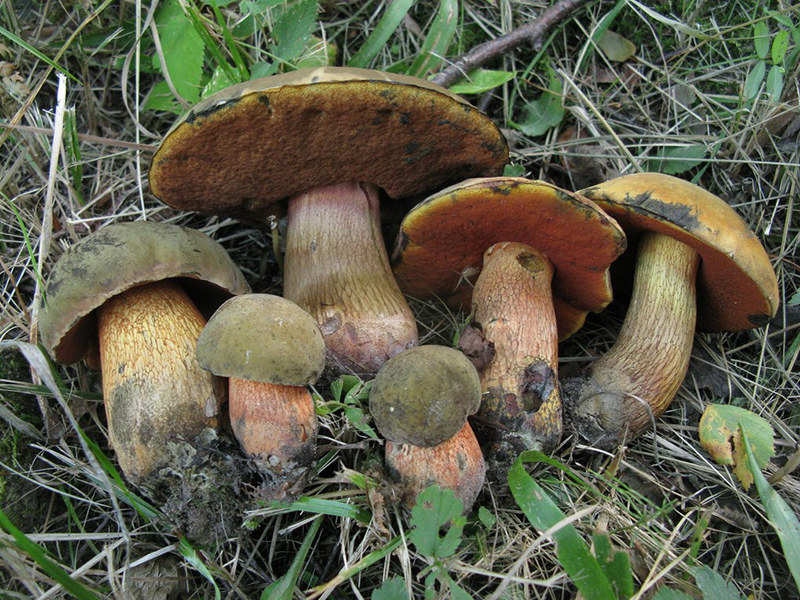
Habitat
Grows singly or in small groups in deciduous forests, mainly in the vicinity of oak trees, prefers calcareous, sandy soils.
Similarity
It bears a resemblance to the poisonous relative of the pink-skinned boletus (Suillellus rhodoxanthus).
|
December |
January |
February |
|
March |
April |
May |
|
June |
July |
August |
|
September |
October |
November |
The nutritional value
A conditionally edible mushroom, many sources recommend using it for food after preliminary boiling for 10-15 minutes, and not using the broth for food.It is also not advisable to consume this mushroom together with alcohol, as this can cause upset of the digestive tract.
Dubovik Kele in medicine.
The benefits of oak woods are enormous. These mushrooms contain beta-glucans, which actively strengthen the immune system. It is also known that Kele's oak trees are a prophylactic agent against the formation of malignant tumors.

The composition of oak wood contains amino acids that strengthen memory, improve movement coordination and reduce the risk of atherosclerosis.
Contraindications to the use of Kele oak wood.
All mushrooms are a rather specific food containing natural chitin. Chitin is useful for the body, but in childhood, an enzyme for the assimilation of chitin is not produced, therefore, it is generally advisable for children under 12 not to crush mushrooms.

Mushroom pickers should be aware that oak trees should be pre-soaked and the liquid drained several times, because if they are poorly cooked, they can cause digestive upset.
Related species of Kele's oak tree.
Boletus Fechtner is an edible relative of the Kele oak tree. The cap is hemispherical, but flatter as it grows. The color of the cap is silvery-white. The skin is smooth and may produce mucus in wet weather. The stem is tuberous, solid, yellowish in color with a red-brown mesh at the base. The pulp is dense, fleshy, whitish in the cap, and slightly reddish in the stem. When cut, the flesh may turn bluish in color. The pulp has no smell.

These mushrooms settle on calcareous soil. They grow in deciduous forests. You can find them in the Far East and the Caucasus. Fechtner's boletuses bear fruit from June to September.
Burroughs boletus is also edible. The hat is fleshy, it can be quite large. Its shape varies from round to flat. The color of the cap is whitish, gray or yellow-brown. The leg is clavate, white, with a whitish mesh. The pulp is dense in structure, with a strong odor and sweetish taste. The color of the pulp is white.

Burroughs boletus grows in coniferous and deciduous forests. They are mainly distributed in North America, but have not been found in Europe. They can settle in large clusters.
Growing a mushroom
Many mushroom lovers or just summer residents want to have edible and tasty mushrooms in their garden, but few know where to start and how this process generally takes place.
There are two ways to grow an oak tree:
Extensive
Thanks to the first method of growing mushrooms, in which all conditions are as close to natural as possible, there are more chances to get a large harvest. This method does not require any special technique or any skills. The only bad thing is that it all depends on the weather conditions and the climate, if the weather is bad, then the mushrooms will be worse and slower to bear fruit.
It is necessary to plant oak mushrooms near deciduous trees, best of all near an oak tree. The plantation where the oak trees will grow should be protected from the sun, that is, direct rays should not fall. Around the tree is removed 20 centimeters in soil thickness of about one square meter. This place should be well watered, then sprinkled with soil prepared as follows:
- mix peat;
- leaves from a tree;
- sawdust;
- horse dung.
Mix everything with the soil and lay around the trunk. On top of this, sprinkle mycelium with dry soil and cover with native soil, removed earlier and "drip" water. In the hot summer months, the soil should be watered periodically, and in winter it should be insulated with moss, leaves that have fallen from wood and straw. You can start such a planting in spring or summer, if everything was done correctly, then after 6 months you can harvest the first crop.
Intensive
As for the second method, it is more effective, since the mushrooms will bear fruit regardless of the climate and weather conditions. The downside is some complexity and investment in this business.It is necessary to equip the mycelium so that there is always optimal humidity, temperature and lighting.
The mycelium must be sown on previously prepared healthy and moist wood. You can cut it 4 days before planting the mushrooms. Then the holes are cut out, and the mycelium is evenly poured into them. You can sow mycelium and pick mushrooms all year round, even in winter. The tree will bear fruit until the mycelium completely destroys it.
Although it is difficult to find an oak tree in the forest, every mushroom picker must put it in his basket and take it home. Everyone should try it, because it is not only tasty and aromatic, but also benefits the body, since it contains many vitamins and microelements. It will improve memory, increase immunity and simply add vigor and strength.
The oak mushroom is also called poddubnik, as it grows mainly in deciduous forests, namely, in oak groves. Outwardly, the oak tree resembles such a well-known and popular mushroom as boletus. But there are a number of differences between these forest dwellers.

| Latin name: | Suillellus luridus |
| English name: | To be specified |
| Domain: | Eukaryotes |
| Kingdom: | Mushrooms |
| Department: | Basidiomycetes |
| Class: | Agaricomycetes |
| Order: | Boletovye |
| Family: | Boletovye |
| Genus: | Borovik |
| Edibility | Edible mushroom |

